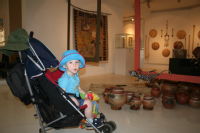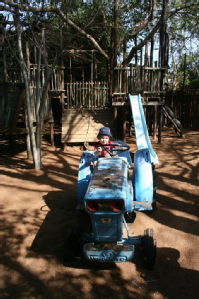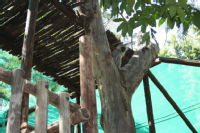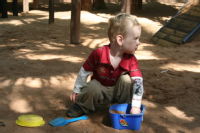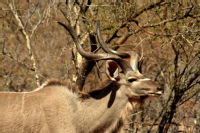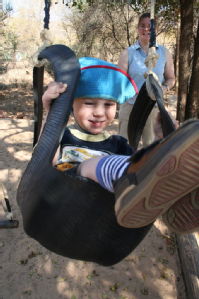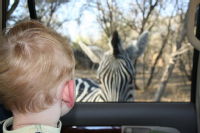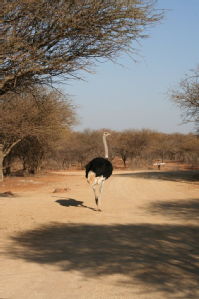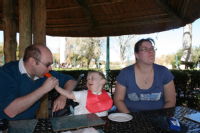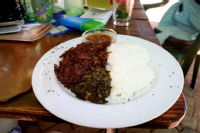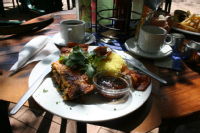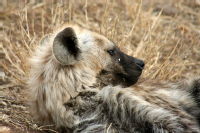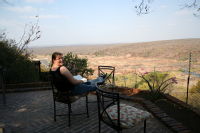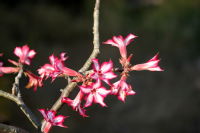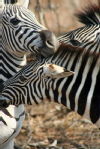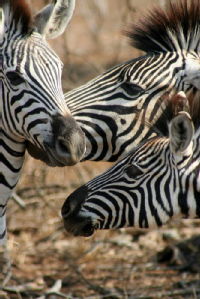All 93 entries tagged Travel Writing
View all 115 entries tagged Travel Writing on Warwick Blogs | View entries tagged Travel Writing at Technorati | View all 66 images tagged Travel Writing
March 07, 2009
Green laning on an R100GS with Continental TKC80 tyres
Follow-up to Travel Report: using Metzeler Tourance tyres off–road from Transversality - Robert O'Toole
Last week my GS was serviced by the very good Behind Bars trail bike shop in Kenilworth. I also asked them to change the tyres. In the last few years I've had several sets of Metzeler Tourance tyres that have worn far too quickly. On a couple of occasions, lumps of rubber have actually peeled away from the carcass - once in the middle of a dash across France. The Continental TKC80 Twinduro tyres are now standard fitment on the R1200GS Adventurer, the modern equivalent of my R100GS Paris Dakar. They seem to be popular. If they are fine on a 105bhp modern bike with lightning fast brakes, they should be OK on my 65bhp airhead with almost no braking power.
Here's a photo of the GS with TKC80s:
Today I went for a test ride, on tarmac (not too fast until they run in) and along a green lane. As one would expect, they proved to be much better in the mud, with no sliding at all. However, surprisingly, they give better grip on the road as well. I suspect that is down to softer grippier rubber. They will last for only 3000 miles, much less than the Tourance.
Here's a close up of the front:
Compare that to a Tourance front, and you can see why they are like tractor tyres off-road:


December 07, 2008
Don't Run, Whatever You Do by Peter Allison
- Title:
- Rating:

The Okavango Delta, Botswana: africa's last great pristine wetland; final sanctuary of the persecuted African Wild Dog; dry-season saviour of one of the last surviving free-ranging elephant populations (over 80,000 of them).
And africa's most expensive tourist destination.
Low-volume, high cost is the rule, interpreted as luxury camping and champagne bush picnics by the handfull of safari companies good enough to win a concession from the local people. It's not a national park. The Delta remains largley in the hands of the local communities, some of whom still live there, and many of whom work in the scattering of camps that dot the wetlands from the pan-handle in the north, through the Moremi Tongue, Dead Tree Island and Chief's Island, and down towards Maun. Amongst them are some of the best safari guides in Africa. People who have lived the entire lives in the Delta. They have an impressive knowledge of nature. Most speak several languages, African and European.
For an outsider to succeed in that game is quite impressive. For one even to survive, where unlike in other countries safaris are commonly on foot and un-armed, is slightly miraculous. And to do so with great humour and friendliness - brilliant.
Peter Allison did just that, eventually becoming manager of a luxury camp. His account of those years gives a fascinating insight into the business, its difficulties and many, many strange events. I've heard anecdotes along these lines before, sit at the bar at Nata Lodge for any length of time and you'll find them hard to escape. But Peter goes well beyond that, with humour and with a great understanding of ecology and tourism. Ultimately, this behind the scenes look might leave you feeling a little bit bemused by the safari business and its customers. The Okavango certainly is a unique place populated by some rather unusual animals. I've never quite felt comfortable there myself - far too fancy!
Here's a few photos that give an idea of what it's like...
Press the play button on the bottom right of the slide show.
September 28, 2008
Les Eyzies et la vallée de la Vézère, Easter 2008
Dinner was taken at Café de la Mairie.
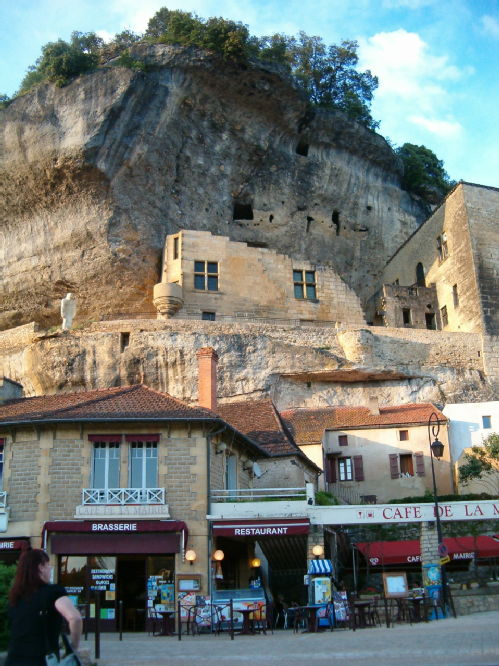
Cassoulet au canard. A worthy reward at the end of a long ride across France.
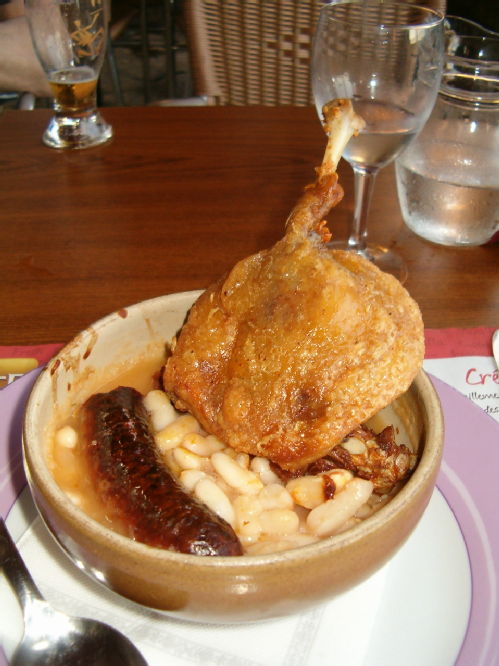
Back across this eccentric bridge…
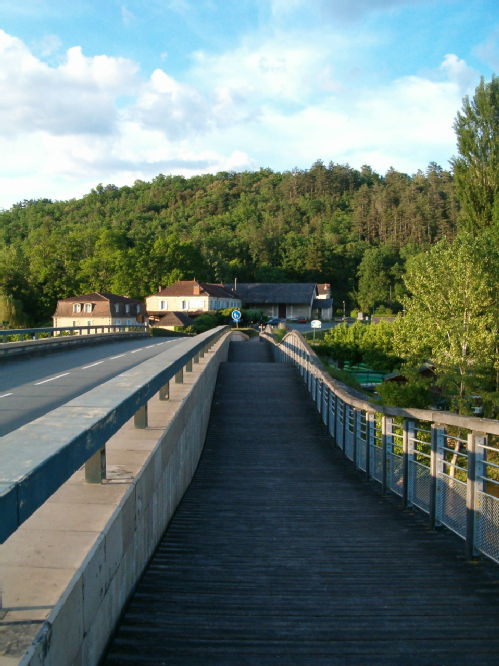
For a good night’s sleep at Camping de la Rivière.
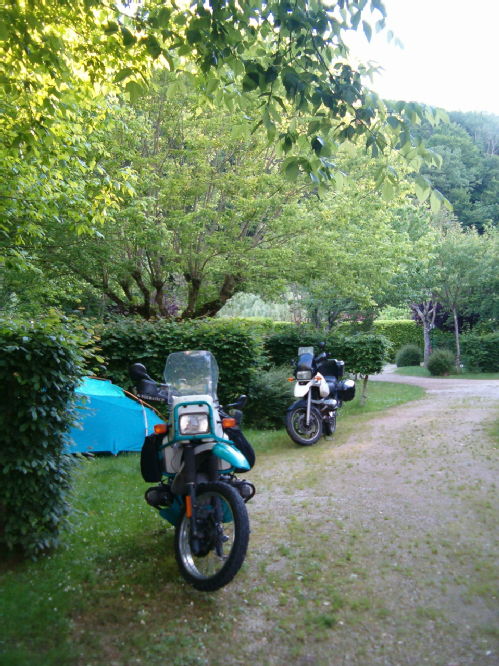
France, Easter 2008
France was empty. An over-priced currency. Inflation. Recession. A low pressure weather system drifting across from the Atlantic. Tourists absent. Saturday afternoon, petering out of a cold and wet Vacances de Pâques, giving no urgency to the light local traffic scattering along the vague peripheries of each small town and village through which we darted. Slipping past thousands of sleepy natives barely noticed, as if a pair of inconsequential swifts returning to England from their annual migration. The happy-warm South and its dusty Mediterranean air behind us.
A fast true road, occasionally lined with Napoleonic regiments of plane trees, but generally more wide open. Imperial Roman straight-line determination overlaying a sensuous rolling Gallic landscape and conquering a hundred miles in a flash: this road, through the Indre Department and up to the Loire, has a dreamlike character. The sensation was the same the first time that the old airhead and I traversed it, riding south to Barcelona in 2001: across the desertified Loire at chateau-grand Samur, launching on to the widely furrowed land. And each time since, its somniferous character has been amplified with a creeping sense of déjà vu. A sense illuminated by the unusual array of brightly painted water towers that dot and dash the landscape signalling to each other across an expanse of farm land, each one firing off a distinct point in my memory, and collectively building up to the tipping point of realisation: a familiar route revisited.
The means by which we select our roads is the same as that used to navigate the unfamiliar dishes listed upon the menus of the relais at which we would periodically stop. Random. Martin’s so-called ‘GPS’ being an in-joke: a tiny plastic clipboard bolted to the handlebar brace of his 1994 BMW R1100GS overlander, carrying small sheets of note-scrawled paper. Martin, professionally, is a microscopist. Miniaturised instructions, his notes work as a minimal roadbook. Complimenting his notes, I carry each relevant page of a dismembered road atlas, folded into the plastic window of a bag strapped across the long-range tank of my rusty trusty old R100GS Paris-Dakar – being an amateur geographer, I have the bigger picture in mind. There is madness in this method, or at least enough eccentricity to keep things interesting. With no particular agreement at any time, either the map or the road book takes the lead. At too in-frequent intervals the pair are brought together on some precarious edge of the road meeting place, and there they form the basic articles for debate and eventual agreement.
Contrary to popular misapprehension, the motorcycle is as much a machine for stopping and comprehending as it is for accelerating and escaping. Even the relatively wide GS, with its sideways protruding flat-twin cylinders may always find some small strip of tarmac, gravel or even dirt on which to perch for a contemplative pause. When confronted by two fat GS’s sat alongside each other, the friendly and tolerant drivers of rural France always give us room. Similarly, when confronted by two motorcyclists (one fat, one thin) sat opposite each other at a restaurant table, the reputedly intolerant waiters of rural France are pleasingly patient. Slow bikes, slow food.
Salade aux noix, andouillette grillée, fromage de chévre bleu s’il vous plaît.
I communicated through imprecisely accented French. The waiter-chef responded with acutely accented eyebrows. There being only two options on the menu, it was either an adventure in offal or cote de porc predictability. Martin chose the latter. Irresistibly, I went for the wildcard. Through the following five minute interlude and the fresh salad starter, occasional glances were exchanged. The waiter-chef would flit between a small kitchen for the preparation of accompaniments and a vast open fireplace upon which the meat slowly cooked. I could read his thoughts: “does the Englishman realise what he is about to eat?”. But could he read mine in return? – “does the Frenchman realise that I really do understand the extraordinarily pungent source of andouillette?”. Starters completed, and the smell of pork began to fill the banquet-sized hall in which we sat. One could easily imagine a small army of musketeers stopping by for a long lunch, perhaps interrupted by a duel, if not a rafter-swinging sword fight defending the honour of France. Serving wenches would not have been out of place, but in this age, they are sadly absent.
When it arrived, it was indeed deliciously medieval.
The waiter-chef lowered the large plate down swiftly, and swept away with efficiency. Striding off into the kitchen, he paused to attend to misaligned cutlery on one of the many un-occupied tables – merely perhaps to enable a check upon my reaction.
I think very highly of the late Capetonian comic actor Sid James. It was undoubtedly a Sid James moment.
I sliced with painful precision through the outer skin, revealing a mess of squiggly chopped-up pig internals and externals.
Andouillette smells and tastes exactly as it appears.
Martin, clearly, was disgusted.
The waiter-chef was perhaps a little bit impressed.
And my verdict?
Very good.
Not necessarily suited to everyday luncheon. But still, very good.
Can I convince you to try this magnificent cut? Perhaps for environmental reasons (eat offal, save the planet)?
Go on, you will not be disappointed.

January 29, 2008
Oxford University Museum of Natural History
Writing about web page http://www.oum.ox.ac.uk/
Housed in a vast Victorian glass-roofed hall, children can wander independently, looking at the hundreds of exhibits. There are cases with displays of land, air and sea animals from across the world, as well as geological and scientific displays.

Lawrence comparing his model sharks to a display of icthyasaurs.
Best of all, of course, are the dinosaurs: both skeletons and life-sized reconstructions.

Lawrence with tricerotops: say RAHHHH!.
Some of the model animals have been created specifically so that children can touch them. The cheetah, pony, fox and badger are particularly attractive.

Lawrence impressing a lady with his zoological expertise.
When we visited a couple of weeks ago, a children’s art event was in progress, with many craft tables in place, at which artists helped the children to create dinosaur masks, puppets and drawings.
Some lesser known highlights:
- There is an upper-level, containing many more exhibits, including beetles, bugs and butterflies.
- Half way up the stairs, there is a live (or dormant in the winter) bee colony, housed in a glass case.
- There is a gruesome skeleton and a model of an angler fish in the fish cases.
- Just to the left of the reception as you walk in, there are mysterious drawers containing further exhibits that can be examined closely.
- The Pitt Rivers museum at the back of the hall displays cultural artefacts from around the world, including some lovely shrunken heads.
- Lewis Carroll drew inspiration from the museum, and there is an exhibit all about him and his creations.
- The hall is lined with statues of key people from the science of natural history – notice how Darwin and Aristotle seem to be staring intently at each other, what are they thinking?
- Dyson hand-driers in the toilets. Bizarrely effective.
After spending a couple of hours in the museum, we visited the very good Strada restaurant in Little Clarendon Street. Seafood linguini, lobster risotto, pizza for the adults. Spaghetti and ragu for Lawrence (along with samples of all of the other orders).
January 06, 2008
Zoo Quest for a Dragon by David Attenborough – review
- Title:
- Rating:

Think of David Attenborough as we know him today: the calm and expert voice; a tall, up-right stance, firmly at home in any environment, in any climate; god-like access to spectacular visions of all of the world’s wildife, no matter how rare or remote. Now strip away half a century and almost all supporting technologies. What remains? A primitive movie camera, a mission to collect interesting species for the London Zoo, his friend the pioneering cameraman Charles Lagus; and an as yet un-proven theory that watchable TV could be produced in this way.
Lost at sea, with only a sketch map to guide them, and razor-sharp coral below…
The ship rocked and staggered so violently that it was all we could do to keep on our feet on the wildly tilting deck. As we desperately thrust our poles on to the reef, the racing water almost tore them from our grasp. We fought with all our strength until at last, driven by the gale, our tiny ship struggled out of the grip of the whirlpool and into deeper water…To retreat was impossible for the wind was blowing directly behind us and to go back we should have had to take the suicidal course of furling our sails and abandoning ourselves to the tidal race. We were irrevocably committed to going on. Within seconds, the ship reared and plunged as the next eddy sucked at her bows.
Some simple advice, in case you ever should need to sail across to the island of Komodo:
- hire a sea-worthy boat;
- make sure that the captain and crew know how to sail it;
- ensure that the captain knows the way to Komodo, or at the very least, can read a map;
- a shared language might help to avoid some of the more disastrous misunderstandings.
There simply were no professionals in 1956. Risks just had to be taken.
Zoo Quest for a Dragon is the story of two young adventurers making it up as they went along. It is the best type of adventure story, written with honesty and humour, and accounting for all of the mistakes as well as the remarkable successes. Attenborough’s attempts at speaking pidgin, often remarkably accurate but sometimes amusingly erroneous, capture the spirit of the expedition. Most people will have seen at least some small elements of the footage that they created whilst in Indonesia. Dragons and orang-utans. Some of the most memorable images from the history of wildlife broadcasting. My copy, a Companion Book Club special from 1959, contains photos, maps and an additional gem: Quest for the Paradise Birds, describing their march across Papua New Guinea. Travelling with large groups of porters in the style of the great Victorian explorers, they encountered not only the amazing dance of the birds of paradise, but also the soon to disappear rituals of the tribes, including pygmies and cannibals (one photo depicts a particularly gruesome necklace made of human fingers).
Many fascinating strands are brought together in this book, in a way that would be unlikely in modern natural history television. Most importantly, it presents the people of Indonesia as part of the environment (although tensions between the two are highlighted). And therein is the real surprise. In describing the many rituals and celebrations of the people encountered, Attenborough proves to be as great an observer of people as he is of animals.
Then, as evening fell, the mood changed again. The music of the gamelan became fierce and full of foreboding, and down the steps from the temple rushed the barong, one of the most powerful and terrible of the spirits of Bali. He was a huge four-legged monster. His body was covered with white shaggy hair hung with gilded leather trappings on which were sewn innumerable flashing mirrors. He had a long golden tail which arched far behind him, decorated with sacred cloths and a tinkling bell. His head was a huge bulbous-eyed mask with savage overlapping tusks and beneath his jaws hung the most magical attribute, a long beard of human hair.
The BBC may soon be making some of the Zoo Quest television programmes available through its online archives project. It will be interesting to see if the Attenborough of this book is all that different to the Attenborough in front of the screen. For now, a short clip is online (Real Player): http://www.turnipnet.com/tv/zooquest.rm
December 12, 2007
The Gypsy in Me by Ted Simon – review
- Title:
- Rating:

In his book The Medieval Traveller, the historian Norbert Ohler estimated that a person travelling by foot, as most did at the time, could expect to cover between 15 and 25 miles a day. A surprising multitude and variety of people were on the road in this manner; whenever war, pestilence and the climate of the time allowed. There were well established routes, often leading to popular places of pilgrimage. For example the Pilgrim’s Way through Kent to Canterbury, along which I once managed to hobble a few muddy miles. There were also more adventurous types out on the road, cutting across these paths, or even escaping altogether, beyond Europe and Christendom. How far we have come since then? A few years ago in Silicon Valley I rashly decided to walk between a train station and a nearby business centre. Walk! For a start no one could give me directions that would be viable for a pedestrian. As I tramped off in the direction that I had assumed to be right, the inevitable road crossings were met with everything from disbelief to aggression. I wonder how many thousands of cars passed me in that hour? One could easily believe that the total number of miles travelled by pilgrims during the entire middle ages would easily be surpassed by the total number of miles travelled by motorised vehicles along the roads of a major city in a single early 21st Century day.
The act of walking is not, in the contemporary mind, in itself heretical. It is the purpose of the walk that matters. Walking for therapeutic or spiritual reasons is considered noble. Walking simply for leisure, given that leisure time now is the sacred, is similarly exulted. But walking out of necessity? Walking as a mode of transport or labour? Walking as a way of life? Walking through urban and post-industrial landscapes, far off the leisure guide’s map – tramping? How offensive does that word sound to us? ‘Tramp’: in reality one of the many terms for the itinerant travellers who walk out of necessity. ‘Gypsy’ is another such word. This prejudice no doubt extends to other lesser forms of transport. In Ireland there is a small but entirely respectable travel industry based upon tourists travelling by horse drawn ‘gypsy’ caravan. And yet who are the most despised, the most abused of Europe’s minorities? – those for whom that is a way of life. The title of the book under consideration, The Gypsy in Me, might at first seem a little odd. It could be read as the story of a diasporic jew’s return. There is indeed an element of that. But the book isn’t The Jew in Me. Ted has a keen and sometimes comic interest in pigs and (organic) pork products; assuring there’s no devotion to orthodoxy or racial purity here. It is an encounter with gypsies, in Romania towards the end of the book, that retroactively adds sense to the fragmented events and sensations of the journey: it is a gypsy journey; the un-constrained, joyous, irreverent, landless, journey of a gypsy; a very different kind of walk, a very Other kind of walk. A journey as old as Europe, and as old as the European paranoia that has repeatedly driven the continent to extremes of persecution and violence.
The Gypsy in Me is travel writing with a radical undercurrent. It contains many propositions that challenge our dangerously cosy Euro dream. It is the story of a man walking, tramping even, across a large part of the continent; not only the picturesque and fertile lands of the Euro dream, but also post-Communist urban and agro-industrial wastes, which seem more determining of the journey’s character. Ted Simon is perhaps more a migrant who writes than a conventional travel writer (although he is brilliantly skilled as the latter). And so travelling is for Ted serious work; sometimes fun, sometimes grim, but always engaged with fully. But there lies the tension in his writing, in his travelling. Successful travel writing is necessarily eventful. That’s its work, that’s what he has to offer to us the readers and to them the subjects of the story amongst whom he travels. He presence makes things happen. But at the same time he must travel lightly, with low social impact, never seeming to be a threat. Finding ‘work’ to do, but not ever threatening the local order. Eventful and ordinary. Magical but familiar. Is such a gypsy journey possible in Europe today?
The journey begins with Ted and two companions. It quickly transforms into a solo effort – as Ted the migrant/writer comes to the fore. It’s never an easy journey, but is throughout reported with good humour. Fun is even poked at some dangerously sore feet (definitely not a leisure walker). It certainly is not a comfortable journey. Which is good. The reality is that Europe is an uncomfortable place for anyone who must walk out of necessity. Europe does not like ‘tramps’, and perhaps never has. The fabric from which it is woven is incompatible with the tramp. It has been that way for a very long time. Think back to those medieval travellers. As Ohler establishes, travelling was even then already part of a highly regulated business. Travelling, by foot, horse or boat, was very much necessary. But already that necessity was qualified by noble motives: for the spirit and for the church. A whole network of hospitality extended to ease the pilgrim on their way. Did this network extend to travellers with other motivations? Surely its purpose was abused by merchants and opportunists (Chaucer gives good account of them). But those who travel out of necessity have always been seen as suspicious. My informed guess is that there is a binary valuation at work in European history, culture, geography, deeply embedded in the European mind: the tramp and the pilgrim, or more recently, the migrant and the tourist. Furthermore, it is a continuum. The identity of the pilgrim slides into that of the tourist, then into that of the merchant, and then, inspiring the kind of fear that drives pogroms, into the ‘racial infiltrator’. This ambiguity, its paradoxes and confusions, are at the base of our confused European sense of self, and I believe, are there in Ted’s book as the problem worked over by the journey. Like most if not all of us Europeans, he is a potentially uncomfortable mixture: Jewish, English, German, Romanian…pilgrim, gypsy, immigrant, migrant, tourist, travel writer.
But then much of Europe is also populated by people who never travel. People who’s people have never travelled – or so they assume. On his journey, Ted finds many of these. In Kaliningrad, it is as if the rotting Russian occupying force, and its commander (Ted befriends his family), had always been there. Almost all traces of the former German town of Konigsberg have been erased and replaced by a new Slavic [dis]order. European history is of course a bloody mess of invasion and occupation. Perhaps it enriches the soil. Nonetheless, the foundation of communities and lineages by fresh migrants must be elided. Conventional wisdom declares this to be the only precaution against a relentless cycle of revenge. Communism regulates and limits travel through stifling state controls. Capitalism regulates travel through an assemblage of values, desires, narratives, and circuits: the travel industry. Even when migration does occur, it is perceived more as a form of eternal holiday (the villa in Spain). In both cases, the required effect is to make the sedentary population feel secure. They may have thousands of people moving through their land, but it’s OK, they are just tourists. The real colonisation is well hidden by the perpetual peace of the happy holidaymaker.
But if a community forgets how to travel, how can it adapt to change? How can an up-rooted farmer move on, ripped from the soil of his cultural and agricultural roots? The elision of travel, of the experience of migration, adds to the pain. Perhaps there is another way? A way of travelling in space and time that avoids conflict and pain?
Ted embraces the fact that travel, of the most primitive and unregulated kind, walking, is a political response to the cycle of revenge, to the ebb and flow of territorialization and deterritorialization. It is the absolute opposite of the blitzkrieg. A person walking can be observed slowly approaching, and thus assimilated physically and mentally by the observer. A car, motorcycle or Panzer, on the other hand, arrives far too quickly. Furthermore, one may see the walker’s face immediately. Individuals on foot tend to seep into consciousness. Could they represent a less threatening means for encountering the political or psychological Other? The book is punctuated by an idea, a very significant notion that seems, even to Ted himself, to be rather eccentric. But given these thoughts on the nature of walking, and the history of walking in Europe, it might not be that mad after all. There’s a dark shadow falling across the whole of the journey, cast from a land to the south: Serbia and Kosova. The atrocities were very much public. As public as the failure of NATO and the UN, with all their vehicles, to stop the killings. Is the idea now obvious? Perhaps the conflict could be seen as a continuum of the tensions between territory and migration, land and travel, repeated throughout European history? In which case the best response might be to subvert the very grounding of that conflict. The proposition was thus: a people’s walk, not a march, an unthreatening gypsy-like joyous drift of thousands of ordinary people, into the war zone.
November 30, 2007
Bitter Lemons of Cyprus by Lawrence Durrell – review
- Title:
- Rating:

And what of the book’s author? He’s pretty adept at this kind of life – island life. He has a reputation as an island poet. Corfu was his family home, along with other animals. Cyprus seems to be a familiar habitat. But his great achievement is this: he gets close enough to the pull of the Tree of Idleness so as to know it like a native, he speaks it’s Greek, he adopts its Byzantine mannerisms and customs; and yet he can pull away when necessary, both physically (making small but intense journeys around the island) and intellectually (seeing the tides of history, politics and empire washing around its mangrove roots). And that then qualifies this not only as travel writing, but genuinely great travel writing – which is never measured in terms of miles traveled on the map. Travel writing as an intensive journey through differences, in time.
What mode of transport is used? If this is travel writing, there must be a vehicle. In fact there are many, small and large, all bobbing around the shallows of the Eastern Mediterranean with varying degrees of shipwrecked helplessness. 571 miles from Athens. 470 miles from Istanbul. 151 miles from Beirut. But amongst this loosely assembled convoy of fates and desires, the principle traveller is the island of Cyprus itself. In the three years covered by the narrative, Cyprus travels a remarkable route. It had already circulated, or been passed back and forth between great powers, East and West, many times. In 2800BC Aphrodite was worshipped. In 550BC it almost floated down the Nile like a papyrus barge. 285BC took it off to Macedon. The birth of Christ was a pull towards Palestine, or rather the beginnings of its conversion into the crusader army’s battle cruiser, sitting menacingly off the Levantine coast. With the great schizm it raised the flag (and murals) of Byzantium not Rome, only to be captured by the Ottomans in 1571. But surely none of that compares to the glory of her Majesty’s Royal Navy? It served her with great devotion, love even, from 1878. And then in 1955, half way through the book, the mutiny began.
The author quickly realised that the historical key to unlocking the culture of Cyprus, as it was before the all-perverting influence of nationalism, was not that of the Ancient Greeks, or even that of Ottoman Islam. Rather, it was a kind of Byzantium. There’s a suggestion that the relative peace within which Greek and Turkish inhabitants cohabited belonged to that of a more ancient civilization, with patterns of daily life more compatible with the landscape and the climate. Each colonizing wave had been assimilated to the island, never conquering it beyond the surface. There were of course differences still, national characteristics, described with a delicious style. A Turkish businessman moves like honey off a spoon – imperceptibly, effortlessly, but still nevertheless purposefully. Durrell’s prose is often, very often, brilliant – way beyond any other travel writer that I know. It is a style that emphasises character without resorting to stereotype, with both efficiency and visual extravagance. Being also an accomplished poet he has techniques and literary tools that other writers never even know of. Principle amongst them is the depth of his knowledge of plants, animals and geography, and the way in which they provide texture and life to the text – rocks, flowers, animals, landscapes, people (their characters observed like an array of species) all permeate his writing, giving its form and its dynamic; the importance of natural history to his prose adds irony to his occasional dig at his zoological brother Gerald (who appears in the book to yet again turn a Durrell house into a menagerie). And it is precisely the observational power afforded by those textual skills that led Durrell to grasp, so well, the forces and movements happening around him: an ancient and unique island ecology battered by storms and turbulent currents from elsewhere.
It would have been easy to write a very different, more stereotypical book. As he discovered when working as a school teacher in Nicosia, the young Greeks were already writing that book. And in that act of national story telling was seeded an invasive weed which would eventually strangle the Tree of Idleness: the Cyprus tragedy. That other story was written under the drugged influence of Lord Byron, hero of Greek nationalism. Durrell tells of young students in his class reciting (badly) tales of Byron, with tears in their eyes. Byron the liberator, Byron the unifier. Throughout Durrell’s story, a paradoxical attitude amongst the Greek Cypriots is observed: they love and respect their British masters, and at the same time they want them off the island. Britain, personified by Byron (who helped to raise a navy to depose the Ottomans), signifies freedom, national unity, racial integrity, and most of all modernity. Greek nationalism, craving ‘enosis’ (unity), was jealous of the United Kingdom of Great Britain. No longer wanting to be treated as children of the Empire, ready to stand alone. In return, the colonial masters behaved with the usual incompetence and misunderstanding, imagining the Cypriots to be an eternally childish people, perhaps even noble island savages. Anthony Eden had more global and devious intentions (Cyprus being not far from Suez, Palestine, Syria), and in secret tensions between Turkey and Greece were being deliberately inflamed. But the colonial administration made a more basic error. Cyprus was part of a Europe that had changed, matured even. But the administration simply could not see that truth. It was no longer an island of farmers, but rather a homeland to a highly mobile international workforce, dispersed across Europe and America. The island that they thought they were governing, the island of the Tree of Idleness, was disappearing fast. And as Durrell smartly observes, by simply ignoring the issue for so long, an extremist result only became more likely – after all, there’s plenty of time to sit around under the tree, or in the café, continually exaggerating the nationalist story; the Cypriots being great story tellers.
Bitter Lemons is a most extraordinary book. As the work of a lyrical travel writer, we first see beauty. And then horror, as the revolt starts to grow. By 1956, when Durrell finally abandoned the island, murder and destruction was everywhere. A true tragedy. But one documented incrementally by a master of lyrical difference, of the slow and imperceptible transformation of things. As a record of normality slipping uncontrollably into chaos, and the failure of politics and administration to even perceive its fate, it is a vital story, a text book even, the crisis being in many ways a precursor to Northern Ireland, Yugoslavia, Palestine. Sadly it seems that it’s lesson has been largely ignored by the politicians who might just have made a difference to those terrible developments. Being optimistic, one could imagine that an ‘enosis’ is now inevitable. Not union with Greece, but rather the union of the whole of Cyprus with the new Europe, the early undercurrent of whose formation was in reality the force that stirred the crisis of ’55. But undoubtedly the politicians will still rabble-rouse and play off minorities so as to get their snouts closer to the trough.November 20, 2007
One Man Caravan by Robert Edison Fulton Jr. – review
- Title:
- Rating:

To mankind’s age old comment on the journey of life that “the first hundred years are the hardest,” the traveler on a motorcycle could add that the first thousand miles are equally tough. p.12
And what of those first thousands miles, down the Dover road and across a depressed Europe, June 1932? Tedium and the uncomfortable wearing together of metal, rubber, muscle and bones that motorcycle manufacturers term “the running-in period”. Robert Edison Fulton Jnr. was perhaps the first of many to take the hard way round: eastwards across Europe, the Middle East, Asia and the USA. Ted Simon recommended this book to me. Bernd Tesch provides the foreward to this recent edition. They both know what it’s like to sit high over a rumbling air-cooled boxer engine for immense distances. Ted and Bernd ride BMW GSs, like mine. As travelers and writers, we are all descended from Bob Fulton, just as the DNA of his boxer engined Douglas bike is present even today in the latest high powered BMW bikes (some authorities claim that BMW copied the Douglas engine for its early bikes, mounting it transversally rather than longitudinally).
Every long journey by motorcycle has its “running-in period”, whether aboard a new machine or revisiting an old companion. But it doesn’t stop there. Beyond that first 1000, there is a slow oscillation around the point at which all runs smoothly. On a bike their is a much tighter and much more critical feedback loop between the environment, the mind and body of the rider, and the machine; all in fine balance, or working their way out of equilibrium:
As the day wore on the sound became more alarming. When I started that morning, the steady drone of the exhaust had been deep and chesty. But now, after half-a-dozen hours of desert driving, it seemed to fill with static, the machine began to wobble, the tires seemed flat, the whole engine seemed on the verge of falling apart, collapsing.
It wasn’t the machine, it was nerves; strung tight, pulled tighter by the constant thought of “what would happen if something happened?” p.65
Ride a motorcycle if you want to know and master paranoia; get a grip upon the awful power of the human mind to envisage even unlikely disasters, and to be pulled head first towards them. Psychologists now call this “target fixation”. If you look at the kerb you will hit it. That’s lesson 1 on day 1 of any riding course.
Bob Fulton’s journey is about transforming that negative target fixation into something positive: how to fall into the right kind of trouble; how to make something out of almost nothing, even amongst the emptiness and desolation of receding empires and expanding deserts. It is quite an amazing story. In many ways such a journey was easier then. America hadn’t given its people an often undeserved bad name. Imperial outposts provided staging points and frontiers linking every hiding place. Even beyond the beat of the colonial bobbies, their influence reached far: his ride into tribal Afghanistan would make a modern traveller deeply jealous. Then it was treacherous, coming at the tale-end of a serious disruption of the internal balance of terrors. Islamic hospitality was his saviour, along with enlightened rulers and friendly peasants. Now, especially for an American, it would be impossible. One is reminded of Chevy Chase hanging upside down from a wooden post: “hi, we’re Americans” – big mistake, one of many.
And after the Middle East and Central Asia, on to “French” Indo-China as it was then, before the first great US foreign policy disaster extinguished that world of relative innocence. He had assumed the service station owner at Angkor, Cambodia, was trying to rip him off. In fact it was the other way round: he was trying to give money to the brave motorcyclist! Bob Fulton realised, as many others have since, that the world is on the whole friendly and helpful, on a personal level. It’s on a more international global level that nightmares erupt. Japan for example, which in 1933 was deeply in love with all things American. If the Kobe Motorcycle Club had achieved the political power that they so clearly deserved, WWII might have been settled on the race track, aboard Indians and Harleys. And Bob Fulton might have been there cheering his new friends on. At a personal level, amongst the small band of Japanese riders with whom he crossed the islands, there could only ever be great respect.
One Man Caravan: a great adventure. Well written, with a scattering of fascinating pictures and maps. Honest. Full of excitement and exoticism, but with many connections between that world (now disappeared) and the present day.October 06, 2007
Five good places to visit in Gaborone, Botswana
Follow-up to Botswana's finest chefs from Transversality - Robert O'Toole
Update: there’s a great new place in town – the No.1 Ladies’ Opera House.
1. The National Museum and Gallery
The museum has recently been renovated with many imaginative displays that illustrate the history, culture, geography and wildlife of Botswana. Highly realistic models and reconstructions are used. Traditional lifestyles are depicted with lifelike models of people (this really got Lawrence confused). Best of all are the models of animals and their habitats. An excellent way to learn.

Lawrence and the lions display (click to enlarge)

Looking at a reconstructed village scene
The museum also houses a gallery, used for displaying the best of current craft works from around the country (many for sale). There are ingenious sculptures, fine basket works, clothing, and much more. Another room hosts temporary exhibitions. In August 07 we saw some great paintings of anachronistic scenes from Botswana life, such as rondavels with satellite dishes.
2. Sanitas Garden Centre and restaurant
See the magic work of horticulturalist Dr. Gus Nilsson and his team of gardeners. Visit the best restaurant in Botswana. Chase the cheeky vervet monkey around the big wooden adventure playground as part of a big group of semi-wild african children. What more could you ask for? Sanitas is Gaborone’s best outdoors attraction. Visitors to Gaborone will probably not want to buy plants, but the displays are interesting in themselves. Use the garden centre as an opportunity to become familiar with the indigeneous flora and its preferred conditions. You may want to buy some of the garden ornaments on sale, such as metal animal and bird sculptures.

A useful coding system is used in the garden
3. Mokolodi Nature Reserve
Mokolodi is about ten minutes drive from Gaborone, along the Lobatse Road. It is a small nature reserve, with largely educational intentions. Non-members can tour the park on an official game drive. Other activities include meeting the orphan cheetahs, rhino tracking, bush picnics, and horse riding. Members can drive around on their own.

My family and other rhinoceroses

Poking a pile of rhino dung with a stick

Drought: normally this would be a lake not a pond

Drought: even the warthogs are being artificially fed
4. Gaborone Game Reserve
600 hectares of land right inside the city. Gaborone Game Reserve offers a chance to see some of the animals typical of the kalahari. Perhaps more significant is the bird life attracted to the large and smelly sewerage ponds that are part of the reserve. Spectacular sightings are certain. Even flamingoes and pelicans are possible.

Lawrence hiding from rapidly approaching zebra
The zebras in the park have an awkward habit: they will put their heads through an open car window in search of food. I once had one chewing the steering wheel. This time I got the window closed in time. Lawrence was amused to watch it licking the window.

Ostrich burying its head to avoid the smell
5. Garden of the Grand Palms Hotel
Eat nice food. Drink underneath shady trees. Watch water birds in the small lake. Swim in the hotel pool. There’s even a children’s play area.
October 04, 2007
How to have a great safari at an affordable price
Which country?
Quick answer: South Africa.
Each of the five main southern African countries has its own slightly different wildlife and tourism infrastructure, offering something a little different to the others. The best developed of these, and of most interest for a first-time safari (or a family trip) is South Africa. Years of political isolation encouraged the further development of an already excellent internal tourism market. For over a hundred years the government and the people have taken pride in and enjoyed a large network of state run national parks. These parks offer an ideal combination: some of the world’s best wildlife and environments, along with brilliantly designed, professionally run and affordable accomodation. There are three major parks boards: SANParks (countrywide), Kwa-Zulu Natal Parks Board, and Cape Nature. Each of these provides efficient booking services (we recommend booking through email, and then confirming and paying a deposit on the phone).
Alongside these many great parks, South Africa also has many private game reserves. Foreign tourists are usually booked into these at great expense. Although they may offer luxury, the much cheaper national parks give a far superior wildlife experience – if you know what to look for.
Of the South African parks, the massive Kruger Park is the best first-time destination, followed by Hluluwe-Umfolozi in KZN. The Kgalagadi (Kalahari) Transfrontier Park stradling the Botswana border offers a very different but also very special desert wildlife experience. South Africa has the additional advantage of the Indian Ocean, making it possible to combine a safari (for example in KZN) with a beach holiday (the KZN coast). Guest houses, booked when you arrive, are the best option for coastal accomodation.
I will write about the other southern African countries soon.
Park fees
There is a daily rate for every visitor to the national parks. This is usually under £10. Compared to the cost of visiting a zoo in the UK, that’s a bargain. The cost can be reduced further by buying an annual membership. SANParks (for the Kruger) offers the WildCard (I think that is around £100 for a family for a year).
What accomodation?
Quick answer: self catering cottages in South African national parks (£20 to £125 per cottage per night).
The national parks in South Africa, Zimbabwe and Namibia provide ‘rest camps’ of various sizes, with a range of reasonably priced accomodation. The rest camps have shops, restaurants, museums, swimming pools etc. Accomodation options are:
- Camping with own tent (usually excellent, with good ablutions) – very, very cheap.
- Pre-assembled walk-in tents.
- Rondavels (small round cottages) with modern bathroom and kitchen – from £20 per cottage per night.
- Guest houses (larger cottages with a lounge, kitchen and several bedrooms).
- Rentmeister donor cottages (big luxury cottages with own grounds, sleeping 8-9 people) – around £125 per cottage per night.
Barbecues (braiis) are provided everywher. Linen and kitchen utensils are included. The bigger cottages may also have a cleaner (who can do laundry and car washing for extra). In the Kruger Park, further options are available. Especially good are the much smaller ‘bush camps’, often with only 10-15 well equipped medium sized cottages. The ‘bush camps’ simply offer a very peaceful and natural experience without shops and restaurants. When staying in a bush camp, you must take in all of the food that you require. Many of the parks now also offer a range of wildreness trails, along which participants are guided over several days walking or cycling, and camping out over-night.
Outside of the national parks, South Africa must also be commended for its thousands of excellent guest houses – they are everywhere, and almost always offer a high standard at a low cost.
Transport
The air fare from the UK is the single biggest expense. Avoid British Airways, for the usual reasons, but also because by flying on SAA the largest share of your tourism £££s goes into the SA economy. Plus, the food is better. Expect to pay around £700 to fly direct, less to go on a long indirect flight.
Once in southern Africa, there is a good network of internal flights. The SAA subsidiaries SA Express and SA Airlink fly from Jo’burg to towns near to national parks. A recent one-way flight for two adults and a child to Phalaborwa on the edge of the Kruger cost us only £60. A recent return flight from Jo’burg to Cape Town on the BA subsidiary Comair cost me £100 (but required booking by phone).
On the ground a car will be essential. In SA you can make-do with an ordinary hatchback or saloon (get air-con), for around £150 a week from any of the major hire companies. These will usually have a limited mileage agreement, but that is fine if you are just pottering around a national park. Cars can be collected from the airports near to the parks. For game viewing, a taller vehicle is better. We recently hired a Honda CRV 4×4 (a soft-roader) over 10 days for £250 from National Alamo – this was perfect. Book online.
There are also several companies that specialise in hiring out fully equipped safari 4×4s and camper vans. I’m really not convinced that such a huge expense is necessary. A serious 4×4 is only needed for very remote locations like the Richtersveld (not recommended unless you are really experienced). And camper vans are rendered obsolete by the great range of camping and cheap accomodation available.
Activities
Once inside a South African national park, there is a great range of activities on offer, either DIY or organised by the park staff. Here are some options:
- Inside the camp – there’s always lots of wildlife to see, including birds and often animals – plus most camps have view points allowing you to watch animals in rivers and water holes.
- Swimming – the bigger camps have swimming pools.
- Restaurants and cafes, often with views.
- Museums and displays – the elephant museum at Letaba is the best.
- Self-drive – just potter about in your own vehicle on the park roads looking for wildlife.
- Picnic sites – in the Kruger there are several picnic spots in which you can get out, wander around, and make your own food. They usually have gas-skottles for hire cheaply.
- Official game drives – with a trained guide – at the larger Kruger Camps, these take place in un-attractively large trucks (around £7 per person), the bush camps use smaller Hilux based vehicles.
- Morning drives.
- Sunset drives.
- Night drives – using powerful searchlights to see night time animals and activities – good chance of leopard in the Kruger Park – the bush camps use smaller vehicles.
- Guided walks – in small groups with a trained guide, expect to get close to dangerous wild animals (around £10 per person).
- Cycling – increasingly popular guided tours.
- Canoing and boat trips – in some parks.
- Specialist drives, looking at trees, birds, stars.
- Sitting by the cottage resting.
What is there to eat?
South Africa has great food. Rest camps have cafes and in the evenings good restaurants, usually with game meat and classic african dishes (bobotie, poitje stew), and often as unlimited buffets. Prices are reasonable, expect three course for under £10.
But eating in restaurants is missing the point. SA is the land of the braai (barbecue). Every cottage has a kitchen and a braai stand. Buy meat in the camp shop (often game meat, or the best imaginable beef). Cook it on the braai whilst drinking good cheap wine or Castle beer. Relax and eat outside, watching the sunset. That’s it.
When to go?
For the Kruger Park, on the north eastern lowveld (low country), the dry season is during our summer. It’s cooler, but still mild. Most importantly, the bush is less thick, so it is easier to see the animals. They may also be more concentrated around rivers and water holes. August is particularly good. Further into the centre of the country, on the highveld, the dry season is accompanied by cold (sometimes freezing). Cape Town is often windy and wet, but warmer for swimming at Christmas. The west coast reverses the rain patterns, with rain during our summer bringing our spectacular wild flower fields.
Surely there are problems?
Yes, but not really many. I’ve had worse illnesses on holiday in the UK, and never experience crime in SA (and i’ve been to Cape Town and Jo’burg). Here’s a list of the more likely problems:
- Dehydration – this is a real danger, and the one that has come closest to hurting me. Drink bottled water constantly. Watch out for salty tap water (I once collapsed with heat exhaustion after drinking salty water at the Makgadigadi Pans).
- Road accidents – South African driving standards are appalling. This has proved to be a major threat to tourists, however, there is a low speed limit inside the parks, which is actively policed.
- Bee and wasp stings – be prepared, carry Waspeze.
- Malaria – in the wet season (Christmas) use Lariam or another powerful anti-malarial, otherwise the Kruger and much of western and central SA is fine.
- Hepatitis – my mother had a bout of this after visiting Botswana, possibly caused by contaminated salad. Be choosy. Only eat uncooked food in places that you really trust.
Are the animals dangerous?
No, not at all. If you follow the rules and respect the animals you will have no problems. Unlike Botswana, SA camps have sturdy fences. If you get out of your car to photograph an elephant bull, expect to get trampled.
October 02, 2007
Botswana's finest chefs
Follow-up to My Family and Other Primates, Kruger Park 2007 Part 6 from Transversality - Robert O'Toole
“Dullstroom” – what a great name for a dorp in the middle of knowhere. I suspect that it is actually a little misleading. I bet there’s excitement if not intrigue to be found along its dusty dry streets. Well at least the fishermen are happy, the game fish growing large in the fresh and lively waters of the area. Several monster specimens are displayed around the bar, preserved in cases. A smaller but much more edible individual was served up on my plate. Possibly the best wild trout that i have eaten.
A comfortable night’s rest was had in an apartment at the Courtyard Hotel in the Arcadia district of Pretoria/Tshwane, followed by a short drive through the Magalisberg Mountains, across the Marico, and home to Gaborone, Botswana.

And the goat is served (ckick to enlarge)
And what of Botswana? Somehow it has acquired a reputation for dull food. Our friends Peter and Johanna are working hard to disprove that claim. The kalahari being goat country, they prepared and cooked a fat juicy leg, marinated in garlic. Fantastic! When slaughtering their own goat, they discovered an extraordinary world of beaurocracy, so now they prefer to buy their meat at JT Butcheries. No matter, it was perfect. Goat is a fine meat, with more depth to its flavour than all but the finest lamb. And yet even in Botswana it is known through the euphemism of “mutton”. At the Taj Indian restaurant, for example, many great goat curries (not curried goat) are served, amongst their other nice dishes.
More evidence of great cooking in Botswana may be found at the Sanitas Garden Centre near to Gaborone Dam. Seswaa, the classic dish of the Batswana, is often on the menu. It is a tasty dish, but hard work to make. Essentially a cow, pounded and smashed to smitherenes, it is slowly cooked to a dry and stringy result, with plenty of fragments of bone and attendant marrow. Alongside the pulverised bovine, one traditionally recieves a good helping of mealie pap (polenta), gravy, and a concoction of green vegetables called ‘morogo’. Spinach seems to be part of the mix, however I’m also told that various kalahari grown wild herbs are essential exotic requirements.
Another southern African classic from Sanitas, bobotie and rice. Minced beef, with a combination of fruit, curry and pepper typical of Karoo cooking, and topped with an egg mix. Again excellent.
A further recommendation: the patio of the Grand Palms Hotel, next to its lake, swimming pool, and play area, serves good home made burgers and salads.
Botswana then is a place for good food. Yes, there are many second or third rate restaurants springing up amongst the brash new shopping malls. And yes, Motswana are adicted to badly fried chicken. But if you know where to look, there are some world class gems.
September 30, 2007
My Family and Other Primates, Kruger Park 2007 Part 6
Follow-up to My Family and Other Primates, Kruger Park 2007 Part 5 from Transversality - Robert O'Toole

A Kruger bull in detail (click to enlarge)
Read the whole story…
1. The boy and his bushbuck, at Letaba
2. Monkeys, not such distant relations
3. Swinging through the trees, near Shingwedzi
4. Lions, a critical assessment
5. Drifting on the thermals, from Shingwedzi to Olifants
6. Elephants are big and grumpy, but fun to watch
Elephants are big and grumpy, but fun to watch
Mafunyane, Shawu, Kambaku, Ndlulamithi, Dzombo, Shingwedzi, Joao, Mandleve, Nhlangulene, Phelwana. We entered the great Elephant Hall in darkness. As I held the door open, Lawrence at my feet and eager to enter, bright sunlight projected shadows of the beasts onto the whitewashed walls within. Ordinarily they were simply massive. Now they had become utterly monstrous. I know the true life horror stories well, they make good tales to tell on long dark nights in the bush. Another of Kruger’s camps has a photo gallery to prove that they are not mere urban myths: cars crushed flat by 7000 kilos of angry Loxodonta Africana; surely no one escaped alive? Sometimes it happens, and no one blames the elephant: the tourist just can’t get the right angle for his camera, so he opens the door and steps out. But that gesture is, to an elephant bull in musth, an irresistable challenge. Hardly a fair contest. At Delta Camp in the Okavango we once felt happy to have been given a freshly constructed reed hut to sleep in. On the first night an elephant brushed past. In the morning they showed us photos of the previous construction, flattened by a tusker in search of fresh water.
When an elephant means business, it nearly always comes immediately and without warning except for a momentary rocking motion of its body; sometimes it comes without a sound. The tail stiffens, the tusks are held high and the trunk is drawn in against the chest. The ears are usually, but not always, spread out to their full extent giving the head a most awesome frontage of 12 feet or more. Bere, R. 1966, Wild Animals in an African National Park
Mafunyane, Shawu, Kambaku, Ndlulamithi, Dzombo, Shingwedzi, Joao, Mandleve, Nhlangulene, Phelwana. Tusks held high against dark shapes like vast threatening ears. In the darkness each of these great tuskers stood threateningly above us, as if still alive and gathered together for a conference of elephant bull ferocity. Ghosts of Kruger’s greatest, a power-cut having summoned them back from the dead. The receptionist in the Letaba Elephant Hall seemed entirely unconcerned. The lights would be back soon, she optimistically claimed. Lawrence does not yet like the dark, so we retreated, returning later to see the awesome collection of elephants, some of the biggest ever recorded. The museum made a lasting impression on Lawrence, we visited five times. He was particularly keen on a jar containing a pickled snake – very much like the Museum of Natural History in Oxford that he loves so much.
Giant elephants are, in the Kruger, not simply a matter of history. We have seen many, and have sat safely watching them for hours. The Kruger is one of the best places to see them. In northern Botswana, along the Chobe river front, it’s not unusual to find several hundred elephants together. From a boat that is spectacular, but when we got trapped amongst them in a bakkie, a rather more tense situation emerged. Add to that the overzealous safari operators, with Landrovers full of $1000 a night guests, then trouble is inevitable. In the Kruger the small family herds seem more relaxed, less harrassed. Whereas the Chobe/Linyanti/Zambezi area has around 100,000 elephants, the Kruger Park has 13,000. And so we can get close and intimate with elephants acting naturally…
(click on a photo to enlarge it)
Here are some photos of a small family herd. They ran fast across the road behind us as we were heading towards Olifants Camp, having climbed up a steep incline from a river bed. A vehicle in their pathway was shooed away like a fly. They then settled into play and grazing, allowing us to get some nice photos.

Does her bum look big in that?
Occasionally elephants are unpredictable. We had been trumpeted on a couple of occasions. Emma claims that I always get too close to the elephants. Lawrence learnt from her to say:
Daddy got too close to the elephant.
But in this case, it was Emma at the wheel of the car, although she could not have predicted that a male in musth would be following the small family herd that had just crossed the road. The big male gave us a trumpet, a bit of ear flapping, and a small mock charge.
Emma’s obvious alarm was actually caused by her inability to get the car into reverse. She had never put an automatic gearbox into reverse before. Not a good time to learn.
We also had a rare opportunity to see a herd of elephants in the rain, making for a very different photograph…
September 24, 2007
My Family and Other Primates, Kruger Park 2007 Part 5
Follow-up to My Family and Other Primates, Kruger Park 2007 part 4 from Transversality - Robert O'Toole
1. The boy and his bushbuck, at Letaba
2. Monkeys, not such distant relations
3. Swinging through the trees, near Shingwedzi
4. Lions, a critical assessment
5. Drifting on the thermals, from Shingwedzi to Olifants
6. Elephants are big and grumpy, but fun to watch
Drifting on the thermals, from Shingwedzi to Olifants
From Shingwedzi in the centre of the park a long hot strip of grey tar runs southwards. It was our route for over an hour, passing through varying degrees of mopane dominated landscapes, interrupted by the occasional dry river bed and cluster of larger riverine canopy.
Mopane gives the north of the park an unfair reputation. In places, that grow-anywhere arid-zone tree is tall and dense, standing as thick mopane woodland on each side of the road. When the poor soils are even thinner and sandier, on the sandveld, mopane is a mere shrub, still densely arranged but short enough for an antelope’s head to protrude through the canopy. Flying across the Kalahari, one sees this landscape in famously endless iteration. The northern Kruger is the southernmost extent of that harsh world. However sometimes, if the conditions are suitable, grassland is interspersed with mopane and other trees, forming a sparse density of vegetation. Such terrain, known as parkland, is more suited to cheetah visioned and lion obsessed tourists. And that is a problem for the Kruger Park Management, who would very much like to attract people away from their over concentration in the big southern camps (Satara, Skukuza etc).
As my pervious journal entries demonstrate, the park to the north is a wonderland rich in a diversity of birds, animals, trees and flowers. There was for us no end to this on our journey south. The trick is to zoom in and around the scenery. Become panoramic, and mopane is breathtaking – a near permanent display of autumn golds and reds. Then zoom back in to find birds and animals scattered around its vastness. At one water hole, near to the Mopane Camp, there is almost always a fascinating crowd gathered: various species of vulture.

Whiteheaded vulture (click to enlarge).
We broke the journey at Letaba, the temperature had climbed to 36 celsius. And then onwards. More mopane. On such long hot days, Olifants Camp is a relief – rising up into the cool breezes that circulate along the high rocky ridge upon which it is placed.

The Olifants River viewed from our patio.
The vast Lebombo Guest House was our eyrie (£125 a night, sleeps 8). From here we could watch eagles, vultures and storks drifting past as they caught the early morning thermals.

A saddlebilled stork passes by.
The Lebombo Guest House is in fact a sprawling complex of three buildings, one of which houses two bedrooms, a kitchen and large lounge, with the other two hosting two further bedrooms each.
The two large patio areas include a braii, upon which I cooked nyala steaks.
The comic rumbling of hippos sounded from far down the mountain side.
Along with water falls as the river cut through the varying strata of rock.
Meanwhile, Lawrence enjoyed his newly discovered sport, lizard chasing.
And went for an elephant ride…
On a morning game drive, Emma photographed a family of hyenas lying next to the road near their culvert den, in exactly the same position that they had been in last time we came to Olifants ten years ago. They do not look like they have moved, or have any intention to do so.
On our second evening, Emma and I had dinner in the restaurant: a superb buffet, with a great game stew not to be missed.
September 19, 2007
My Family and Other Primates, Kruger Park 2007 part 4
Follow-up to My Family and Other Primates, Kruger Park 2007 part 3 from Transversality - Robert O'Toole
1. The boy and his bushbuck, at Letaba
2. Monkeys, not such distant relations
3. Swinging through the trees, near Shingwedzi
4. Lions, a critical assessment
5. Drifting on the thermals, from Shingwedzi to Olifants
6. Elephants are big and grumpy, but fun to watch
While staring at an unusual object it cannot identify, an impala will move its head up and down and sideways, apparently to see it more “in the round”. Estes, The Behaviour Guide to African Mammals, 1991, p.166
Estes provided, as ever, a reliable description of the African tableau before our eyes. For some time, animals moved backwards and forwards along an area of open space above a small vlei, half an hour’s drive to the north of Oliphants Camp in the Kruger National Park. A string of zebras, wandered through small groupings of impalas, an animal accurately described by Estes as “the perfect antelope”. An occasional wildebeest mingled and munched upon the sparse but adequate vegetation. Nothing unusual. Just another day on the way to the waterhole.

Assorted zebras and impalas – click to enlarge
Observing closely the black scent glands on the hind legs of a large buck impala, I was reminded of a closer encounter from a few years earlier. It was then, on the day of our wedding in Hwange National Park, that we had an opportunity to observe this typical mopane-veld resident at very close range indeed. The hosts at the venue for the happy day, Jijima Camp, had “adopted” an impala – or perhaps more accurately, had been adopted by one. The animal slept next to our tent, as it would every night, ruminating in relative safety. Although leopards and lions are occasional visitors to such un-fenced camps, the impala was probably correct in assuming that close association with humans would offer a greater degree of security from survival of the fittest. And this then is how my copy of Estes obtained its unusual signature. Buck, as the impala was known, stood just a couple of metres from the front of our tent. A male impala, complete with horns, is at close range quite an impressive sight. However, all of its dignity is immediately lost when it starts to bob and weave its head in the quizical manner described above. Buck was obviously confused by some aspect of the scene that I presented. My inevitable laughter only made him more agitated. In an effort to diffuse the situation, I sought to restore the natural order by reading aloud to him the prescription of ideal impala behaviour given by Estes in the very book that I was at that point casually flicking through. I then gave Buck the opportunity to confirm or deny the stereotype of his kind presented by the finest of zoological minds. And what was Buck’s response? In a flash he lept forwards, and with his powerful jaws ripped the book out of my hands, tossing it high into the air. I dived out of the way to avoid being impaled by his horns. And so pages 137 to 156 of my copy of the Behaviour Guide to African Mammals are now indelibly imprinted with the teeth marks of an impala, that most perfect of antelopes.
The memory of Buck amused me for long enough to be surprised upon the return of my attention to the current scene. Some unidentifiable tension had stirred during my reverie. The behaviour was again that of a quizzical impala buck: upright stance, twitching ears and tail, moments of concentration interspersed with that comical bobbing and weaving. He was, as Estes says, trying to see something more “in the round”. And we knew exactly the cause of this sudden alertness. Just after setting off from Oliphants, the driver of the early morning game drive had tipped us off. Lions had been spotted, he said, giving a quick and simple description of their location. We thought that Lawrence might like to see them, not having done so before. Otherwise, we may not have bothered. And here they were, as described, two females lying beneath a small tree. For some time potential prey had passed by seemingly unaware of the deadly duo within easy ambush range. Until finally contact was made between killer lion and lion food.

The stand-off – click to enlarge
How terribly dramatic. Imagine the Jonathan Scott commentary, suggestively hushed. Imagine the camera crew poised to get the kill in the can. Imagine the millions of viewers earnestly believing that this is real Africa.
Oh dear, and now I have to spoil the illusion. For reality is rarely like the movies, especially when a lion is in a leading role. To continue the Hollywood analogy, the truth is that they are more like Brando than Brosnan. Big fat and lazy. With huge potential and a very occasional blockbuster, but more suited to lying flat out next to the pool for days on end sipping Martinis. This impala knew the score, and was entirely unworried. Even his brief expression of interest waned quickly. Hundreds of other prey animals in the area didn’t even bother to look, although they must have known that the lions were there. Lawrence agreed. The lions were of no interest. “Where’s the monkeys?”. After the event, we have to remind him that he has seen lions, because the reality is nothing in comparison with the Lion King.

Unimpressive lions – click to enlarge, if you really want to
While ambling slowly back to the camp, Emma and I recalled our many encounters with lions, from our many many safaris. We both sense that we have seen many lions, although the sightings tend to blur into one vague impression. Sightings of cheetah, leopard and even wild cat always stand out, partly due to their rarity, but more as a result of the stunning presence of those lesser cats. There was a particularly notable male lion that I tracked along a road in the Kalahari Gemsbok Park. He had a black mane, and seemed massive, with the top of his head reaching above the window of our Hilux (a really tall 4×4). Emma wound her window up with unnecessary haiste. And then there were the lions that visited our lonely camp at Nqwethla, deep inside Hwange. We had already been driven out of our tent by an elephant. I had spent part of the night pouring parafin onto an open fire so as to scare the pachyderms off with a fireworks show. The flames seemed to at least distract the elephant from the task of trashing our camp. But they had no effect upon the noisy family of lions that walked by as we hid.
So you want to go to Africa? You deperately want to see lions? Our long standing family joke is this: one year in Hwange, a party of very annoying Americans spent their time racing around the bush, repeating the same question with urgency – “have you seen any cats?” (said with annoying American accent). Of course they missed the wild dogs, bee-eaters, and troop of banded mongeese.
Do you still want to see lions being interesting, just like on the TV? There is one last possibility. We tried it a few years ago. It works like this: Go out walking with a really good game ranger. We were lucky to walk with the legendary Frank Watts at Shimuwini Camp in the Kruger. When you spot many lion tracks, just believe him when he says that it’s perfectly safe (assume that he means that they are long gone). Then follow him up a hill, heading towards the most foul smell of death imaginable. At the top of the hill, examine closely the big runny black slick of lion crap. Proceed further, nominating a charmingly innocent member of the party to take the lead. Emma was rather surprised when a big lioness ran across her path. As we approached the half eaten carcass of a buffalo, we could hear the rest of the pride running in all directions. Yes, we had driven a pride of lions of its kill. Cowards. Frank examined the carcass for signs of bovine TB, a serious issue in the Kruger. It looked healthy. With the light fading, we slowly wandered back to the Landcruiser. Being at the back of the line, I was last to get into the safety of the vehicle. While waiting for my turn, I sensed movement behind me. I turned as I climbed into the open back of the vehicle. A fully grown male lion, complete with impressive mane, stood staring assertively at us. I could read his mind: “don’t mess with my dinner – or next time you’re dessert.”
Recently, Frank hit the headlines as the safari guide in the world famous “battle of the kruger” incident, the video of which is on YouTube. Amazingly, a herd of buffaloes fought back against a pride of lions that had taken one of their young. The buffalo survived. The lions almost didn’t. It may even be the case that this is the same cowardly pride that we encountered several years earlier.
Importantly though, I must say that the best drive that we’ve been on with Frank typified the ideal game drive. On a sunset trip there were no lions, but rather a sequence of fascinating insects and birds, including a nightjar and a sun spider.
You can find out more about Frank’s work on the Thompsons Indaba Safari Company web site.


 Robert O'Toole
Robert O'Toole

 Please wait - comments are loading
Please wait - comments are loading

